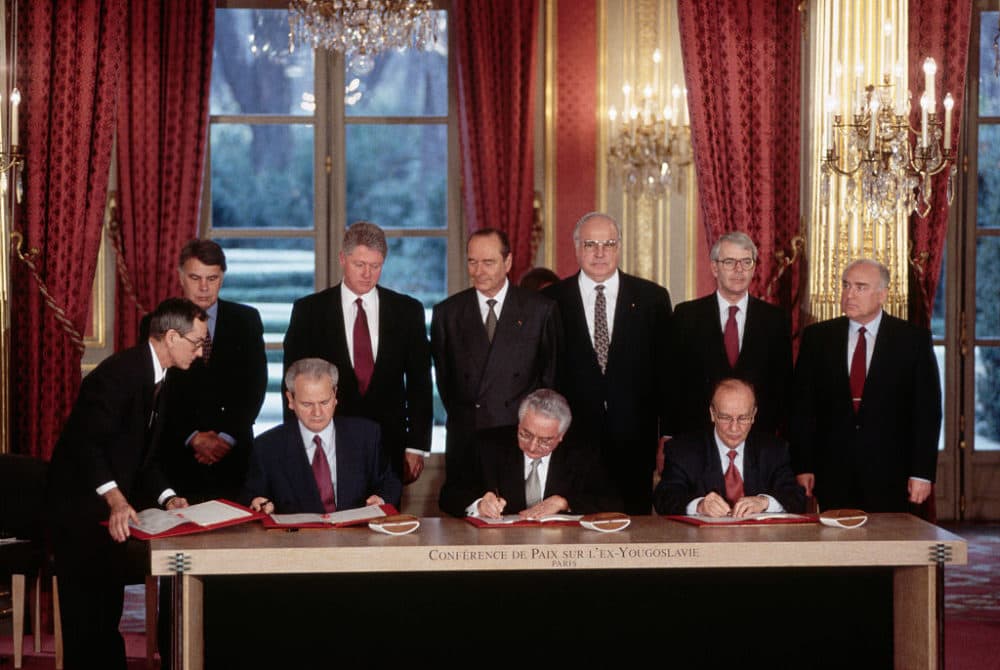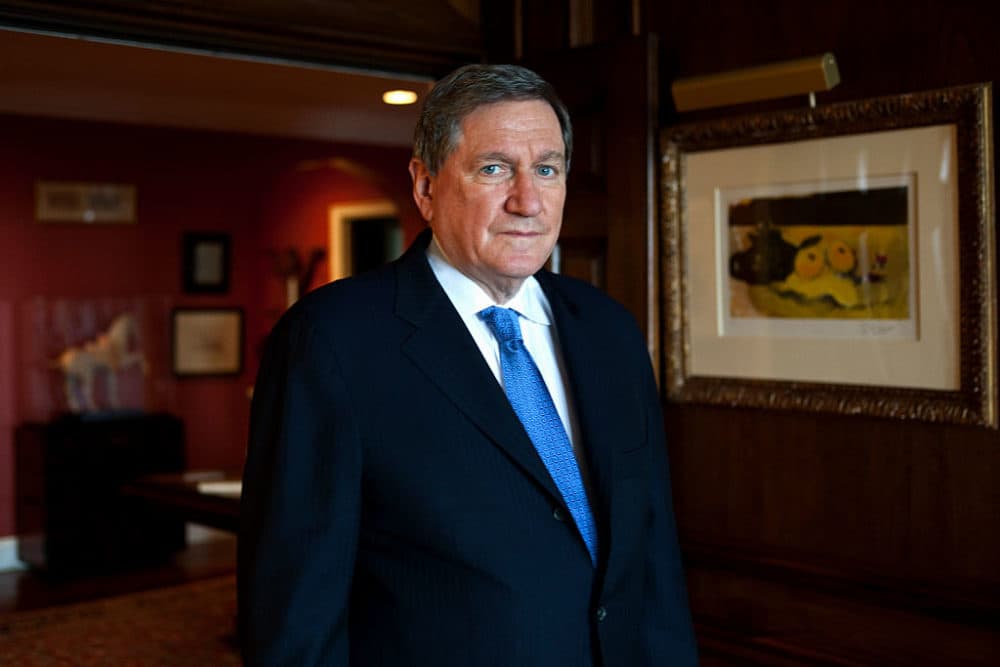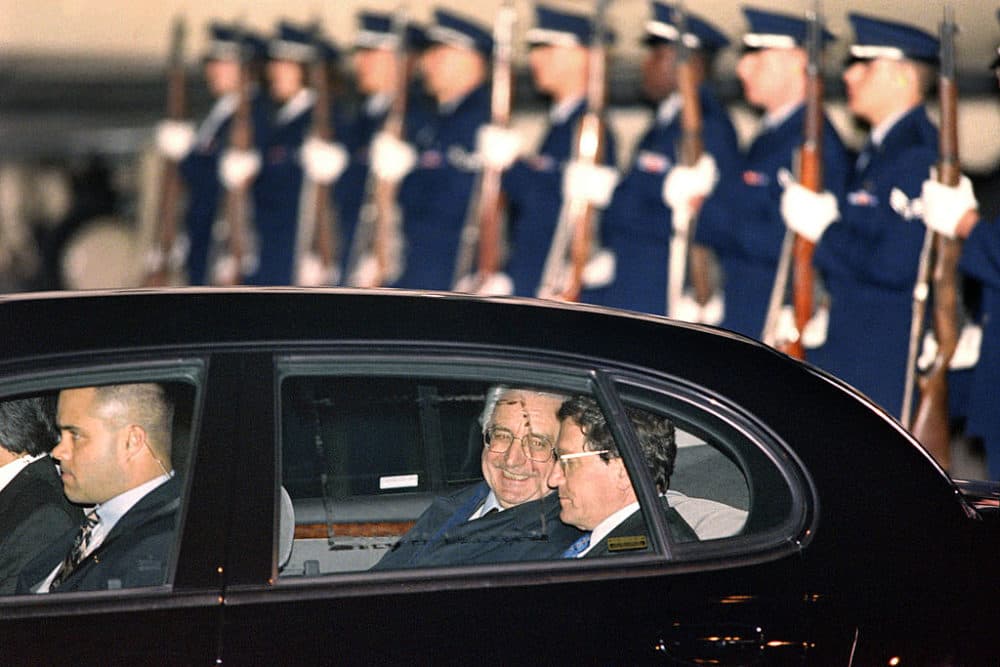Advertisement
How Diplomacy Forged The Dayton Accords That Brought 'Uneasy Peace' To Bosnia 25 Years Ago
Resume
A quarter century ago this week, a landmark peace agreement was signed that ended an especially brutal war in Eastern Europe.
The Dayton Accords put a stop to ethnic violence among Serbs, Croats and Muslims in the Balkans.
The war reached its peak with the worst massacre in Europe since World War II when the Bosnian Serb Army murdered 8,000 Bosniak Muslim men and boys in what was supposed to be a United Nations safe haven in the town of Srebrenica.
The Srebrenica genocide, which occurred in July of 1995, prompted former President Bill Clinton and NATO to launch a bombing campaign that led to a cease-fire and eventually the Dayton Accords.
There was one U.S. diplomat in particular whose strategic maneuvers brought the peace talks to fruition — the late Richard Holbrooke.
In November 1995, Holbrooke pressured three presidents of the warring factions — President of the Republic of Serbia Slobodan Milošević, President of Croatia Franjo Tuđman, and President of Bosnia and Herzegovina Alija Izetbegović — to come together at the Wright-Patterson Air Force Base near Dayton, Ohio.
Nicholas Burns, a former State Department official, was in Dayton when the agreement was signed. He served as Holbrooke’s right-hand man during the grueling 21-day negotiation process.
All credit for accomplishing the peace deal goes to the “highly assertive” and “brilliant tactician” Holbrooke, who knew that the three warring presidents wouldn’t negotiate unless forced to, Burns says.

The three presidents had so much hatred toward each other that there was no other way but to separate them, he says. So Holbrooke decided to utilize a strategy called proximity talks, Burns says.
“The Bosnian Serbs had one floor and the Croats had another and the Bosnian Muslims a third, and the Americans and Europeans and Russians a fourth,” he explains. “And Holbrooke literally shuttled between rooms and between floors, traveling 20 yards, 40 yards to a meeting where he would talk to each of these presidents and try to forge an agreement.”
Holbrooke also understood that letting these men talk to the press would potentially sink the peace negotiations. The diplomat was able to convince them not to talk to the media on the record during the negotiation period, Burns says.
That tactic was crucial to getting the countries to stay on track, he says.
“This is pre-internet, this is pre-social media, pre-Facebook,” Burns says. “We were able to control the message that came out of Dayton, and they couldn't use their public remarks as a platform to denounce each other. I think that was a very important part of this.”
The result was an agreement that preserved Bosnia as a single state made up of two parts, the Bosnian Serb Republic and the Federation of Bosnia and Herzegovina, and brokered peace in the area.
The Dayton Accords was an enormous feat on the part of the U.S. to stop horrific levels of violence. But since the brutality ended 25 years ago, divisions remain. Crushing political, social and economic problems persist in the reconfigured region.
There is little interest among political leaders to work together. Unemployment, especially among young people, remains sky-high. Poverty plagues the citizens there, and perhaps symbolically, they can't even agree on the words to a national anthem.
These difficulties, from the modern perspective, signal an “uneasy peace,” Burns says. The objective in 1995 was to stop the “savage war” and establish a government with decentralized power, he says, something the Dayton Accords did accomplish.
U.S. administrations since — including ones he’s worked on — have tried to strengthen the peace deal, but without significant progress, he says.
“It's an incomplete peace, but it is a peace. And you haven't seen anywhere near the type of fighting and bloodshed in the last 25 years as during the time 1991-’95, when this was the greatest crisis in the world, the most horrific,” he says. “And so I think Holbrooke did well. The United States can be proud of the effort that it made at the Dayton peace talks.”
Interview Highlights
On Holbrooke’s role in getting one party to agree with the other two
“They couldn't really envision peace, not in any specific way, not in words on a document. And so the American delegation, led by Richard Holbrooke, essentially wrote the Dayton Accords for them. And these were very complicated accords because borders were being adjusted. Armies had to recede or advance depending on the terms of the treaty. Ethnic groups had to be protected because, of course, that was the major issue in this war, the tremendous loss of human life, the reprisals by the Bosnian Serbs against the Muslims in Srebrenica — horrific war crimes. This was a very complicated, very complex agreement written essentially by the United States with the help of the European Union and the Russian government. And Holbrooke was the chief negotiator.
“These were 18 to 20 hour days. He purposely kept them working late at night. Early in the morning, he kept the pressure on. He would often use the press or ask me to use the press to put pressure on them. And he also used the threat of walking away. I think at about the 18th or 19th day, we were supposed to end the peace conference and we did not have an agreement. And Holbrooke said, ‘We're going to make them think that we're going to walk out.’
“And so everyone packed their bags, put their bags outside their hotel rooms. He brought an airplane up, engines revving just to simulate the fear that maybe we the negotiators would walk away and they would be left with no agreement. And there was a decision made at that time that we would go into what we called extra innings. We had to translate that for the Europeans to say extra time, which is a world football term, not an American baseball term. And those last two days really were the days that broke this agreement open and allowed the agreement to take place — which stilled the guns, which ended the killings and which has brought a generation of peace to Bosnia-Herzegovina.”

On why the warring parties continued to negotiate when they had so little interest in working with each other
“Well, by that time, the bottom had fallen out for the Serbs and the Bosnian Serbs that had been the dominant party. They had begun to experience reversals to the Bosnian Muslims and the Bosnian Croats on the battlefield. [Bosnian Serbs], of course, had been subjected to NATO airstrikes because of their human rights atrocities that they carried out against civilians. And they didn't want to return to a future where they might even lose more territory.
“I think for the Bosnian Croats, they needed a deal to move forward. It was difficult for the Bosnian Muslims and for President Izetbegović because they considered themselves, quite rightly, to be victims here. There was tremendous loss of life on their side, and yet peace was the greater imperative. And so I think all of them were ready for a deal, but they couldn't get there without this American vision, international vision led by the United States and by the sheer force of personality and energy and persuasiveness of Ambassador Richard Holbrooke.”
On Burns’ role in coordinating press conferences each day to try and convince the press to keep pressure on the three parties
“I was in constant contact with Holbrooke, either on site at Dayton or when I was back in Washington. From time to time, I would give these press conferences and Holbrooke and I would talk ahead of time and I'd say, 'What's the point of emphasis today? Do you want to put pressure on this leader or that leader?' And he would tell me yes or no, and he would give me some ammunition for the press conference.
“That was an attempt by the United States to control the message, to place pressure on some of these political leaders in their home countries so that they would finally make the kind of compromises that are necessary in a very difficult peace agreement of this sort.”
“... Holbrooke, when he talked to the press or when I talked to the press, we were using real world examples from the negotiations of who needed to do more, who needed to work harder, who needed to make a greater effort to compromise for the greater good of ending this war once and for all.”
On the official signing of the Dayton Accords
“What's interesting is that this agreement was reached at Dayton, Ohio, on Nov. 21, 1995. It was initiated then. It was signed by the leaders at a ceremony in the Élysée Palace in Paris in December 1995. The French government, which had played a role in these negotiations but not the dominant role played by the United States, wanted to convince the world to call this the Treaty of the Élysée. And we worked behind the scenes, Holbrooke and I and others, to make sure that it was called and would be named forevermore the Dayton Accords.”
Alex Ashlock produced and edited this interview for broadcast with Tinku Ray. Serena McMahon adapted it for the web.
This segment aired on December 15, 2020.
